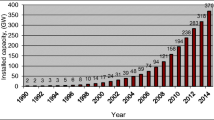Abstract
The wind velocity spectra at Beijing Meteorological Tower are calculated using Hilbert-Huang transform and Fourier transform, respectively. A innovative model of wind velocity spectrum, which is accordant with the characteristics in both the inertial subrange and the large eddies range, is presented in this paper. The method of least squares is adopted to obtain the parameters in the model. Then the differences between the FFT spectrum and the HHT spectrum are compared. It is indicated that the values of the HHT spectrum in the energy containing range are slightly larger than those of the FFT spectrum while the values of the HHT spectrum in both inertial subrange and dissipation subrange are very close to that of Fourier spectrum. It is concluded that the HHT spectrum describes elaborately and accurately the spectrum values in the low frequencies and the fitted wind velocity model provides a reference for reconstructing the near-ground wind field of Beijing city in wind tunnel test and for numerical simulation.
Similar content being viewed by others
References
Richardson L F. Weather prediction by numerical process. Cambridge: Cambridge University Press, 1922
Kolmogorov A N. The local structure of turbulence in incompressible viscous fluid for very large Reynolds numbers (in Russian). Dokl Akad Nauk SSSR, 1941, 30: 299–303
Heisenberg W. Zur statistischen theorie der turbulenz. Max Plank Institute fur Physik, Gottingen, 1946
Weiszacker C F V. Das spectrum der turbulenz, Max Plank Institute fur Physik, Gottingen, 1946
Pao Y H. Structure of turbulent velocity and scalar fields at large wave-numbers. Phys Fluids, 1965, 8: 1063–1075
Heisenberg W. On the theory of statistical and isotropic turbulence. Proc R Soc London Ser. A, 1948, 195: 402–406
Batchelor G K. Kolmogoroff’s theory of locally isotropic turbulence. Math Proc Cambridge Philos Soc, 1947, 43: 533–559
Batchelor G K. The Theory of Homogeneous Turbulence. Cambridge: Cambridge University Press, 1953
Simiu E, Scanlan R H. Wind Effects on Structures: Fundamentals and Applications to Design. 3rd ed. New York: Wiley, 1996
Tieleman H W. Wind characteristics in the surface layer over heterogeneous terrain. J Wind Eng Ind Aerodyn, 1992, 41: 329–340
Karman T V. Progress in the statistical theory of turbulence. Proc Nat Acad Sci USA, 1948, 34: 530–539
Solari G. Turbulence modeling for gust loading. J Struct Engrg, ASCE, 1987, 113: 1550–1569
Wyngaard J C, Cote O R, Rao K S. Modeling the atmospheric boundary layer. Adv Geophys, 1974, 18A: 193–211
Deaves D M, Harris R I. A mathematical model of the structure of strong winds. CIRIA Report 76, Construction Industry Research and Information Association, London, U K, 1978
Engineering Sciences Data Unit. Characteristics of atmospheric turbulence near the ground. Part II: Single point data for strong winds (neutral atmosphere). ESDU 85020, ESDU, London, U K, 1985
Fichtl G E, McVehil G E. Longitudinal and lateral spectra of turbulence in the atmospheric boundary layer at the Kennedy Space Center. Appl Meteorol, 1970, 9: 51–63
Simiu E. Wind spectra and dynamic alongwind response. Struct Div, ASCE, 1974, 100: 1897–1910
Solari G. Gust buffeting. I: Peak wind velocity and equivalent pressure. J Struct Eng, 1993, 119: 365–382
Lumley J L, Panofsky H A. The Structure of Atmospheric Turbulence. New York: Wiley, 1962
Kaimal J C, Wyngaard J C, Izumi Y, et al. Spectral characteristics of surface layer turbulence. Quart J Roy Meteorol Soc, 1972, 98: 563–589
Hino M. Spectrum of gusty wind. In: Proceedings of the 3rd International Conference on Wind Effects on Buildings and Structures, Tokyo, Japan, 1971. 69–77
Harris R I. The nature of the wind. In: Proceedings of the Seminar on the Modern Design of Wind Sensitive Structures, Institution of Civil Engineers, London, 1970. 29–55
Kareem A. Wind induced response analysis of tension leg platforms. J Struct Engng, ASCE 1985, 11: 37–55
Tieleman H W. Universality of velocity spectra. J Wind Engng Ind Aerodynam, 1995, 56: 55–69
Davenport A G. The spectrum of horizontal gustiness near the ground in high winds. Q J Royal Meteorological Soc, 1961, 87: 194–211
Simiu E, Leigh S D. Turbulent wind and tension leg platform surge. Struct Eng, ASCE, 1984, 110: 785–802
Huang N E, Chern C C, Huang K, et al. A new spectral representation of earthquake data: Hilbert spectral analysis of station TCU129, Chi-Chi, Taiwan, 21 September 1999. Bull Seismol Soc Am, 2001, 91: 1310–1338
Kareem A, Kijewski T. Time-frequency analysis of wind effects on structures. J Wind Eng IndAerodyn, 2002, 90: 1435–1452
Xu Y L, Chen J. Characterizing nonstationary wind speed using empirical mode decomposition. J Struct Eng, 2004, 130: 912–920
Li Q S, Wu J R. Time-frequency analysis of typhoon effects on a 79-storey tall building. J Wind Eng Ind Aerodyn, 2007, 95: 1648–1666
Huang N, Shen Z, Long S, et al. The empirical mode decomposition and the Hilbert spectrum for nonlinear and non-stationary time series analysis. Proc Roy Soc Lond, 1998, 454A: 903–993
Author information
Authors and Affiliations
Corresponding author
Rights and permissions
About this article
Cite this article
Tian, Y., Yang, Q., Yang, N. et al. Statistical spectrum model of wind velocity at Beijing Meteorological Tower. Sci. China Technol. Sci. 54, 2869–2877 (2011). https://doi.org/10.1007/s11431-011-4551-5
Received:
Accepted:
Published:
Issue Date:
DOI: https://doi.org/10.1007/s11431-011-4551-5



